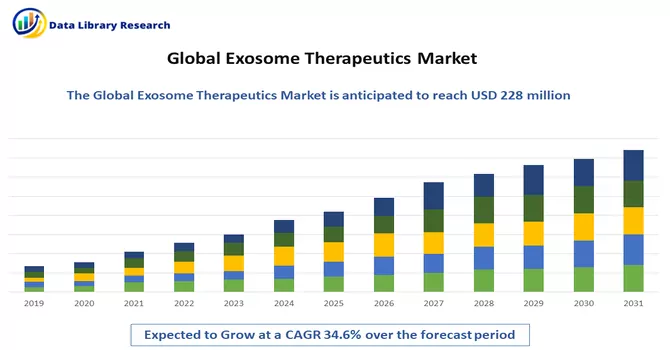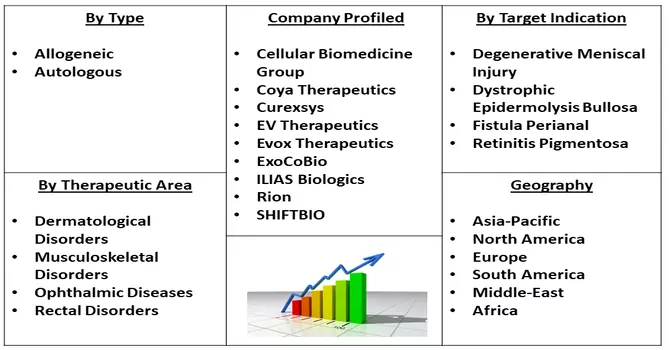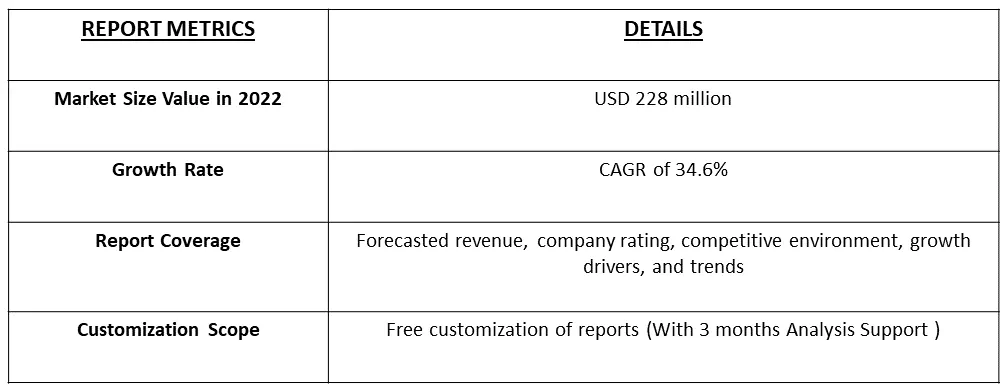The Exosome Therapeutics Market is currently valued at USD 228 million in the year 2022 and is expected to register a CAGR of 34.6% over the forecast period, 2023-2030.

Get Complete Analysis Of The Report - Download Free Sample PDF
The Exosome Therapeutics research team is developing a novel regenerative medicine based on stem cell-derived nanoparticles called exosomes. Stem cell exosomes are packed with a diverse array of regenerative factors that help regulate the immune system and facilitate wound healing.
The exosome therapeutic market share is expected to witness significant growth over the forecast period due to the increase in the prevalence of chronic disease, infectious disease, autoimmune disease, and cancer and a surge in demand for molecular diagnosis. In addition, ongoing advanced exosome technology in drug development and discovery yields valuable information regarding the heterogeneity and biological function and enhances the ability to harness the therapeutic and diagnostic potential for cancer & and infectious diseases. Thus, advancement in technology in the healthcare sector propels the growth of the exosome diagnostic market and exosome therapeutic market. The Increase in demand for drug therapies and surge in R&D activities in the pharmaceutical and biopharmaceutical field is stimulated by the potential of exosome technologies as diagnostic and therapeutic tools are used for the treatment of various diseases, including neurodegeneration, cardiovascular dysfunction, and cancer.
The exosome therapy market is presently growing at a significant pace among the dynamic sectors of the pharmaceutical industry. At present, near about 120 pipeline therapeutic candidates are present in the studied market, and this number is anticipated to grow further in the forecast period. Furthermore, nearly 40% of the total number of drugs are in the clinical stage of development. Of the total candidates, seven exosome therapies, including EXOMSC-COV19 (Dermama Biotech Lab), Dex2 (Gustave Roussy Institute), SF-MSC-EX (Osmangazi University), are currently being evaluated in the advanced clinical stages of development. Moreover, around 30% of the exosome therapeutics are being developed for the treatment of cancer. Exosome-based therapy for cancer is a novel approach and the drugs are currently in the early stages of development. Breast cancer, lung cancer, melanoma, and colon cancer are among some of the oncological indications where exosomes are being tested as delivery vehicles for targeted therapy.
Segmentation:
The Exosome Therapy Market, Distribution by Type of Therapeutic (Allogeneic and Autologous), Target Indication (Degenerative Meniscal Injury, Dystrophic Epidermolysis Bullosa, Fistula Perianal and Retinitis Pigmentosa), Therapeutic Area (Dermatological Disorders, Musculoskeletal Disorders, Ophthalmic Diseases, and Rectal Disorders), and Geography (North America, Europe, Asia-Pacific, Middle East, Africa, and South America). The report offers the value (in USD million) for the above segments.

For Detailed Market Segmentation - Download Free Sample PDF
Drivers:
Growing Cancer Cases
The growing prevalence of cancer patients directly impacts the increased demand for exosomes. According to the GLOBOCAN 2020 report, 19.29 million people are living with cancer, and this number is expected to rise over the next two decades across the globe. With the rising number of cancer cases, it is believed that the application of exosomes in coping with cancer would be high, which is expected to contribute to the market growth.
Increasing R&D Developments
The recent R&D developments in the exosome therapeutics market are expected to fuel the growth of the studied market. For instance, in July 2022: Cells for Cells, a clinical-stage biotech pioneering allogeneic stem cell and stem-cell-derived therapeutics for high-impact chronic diseases, announced a 6-month follow-up of the groundbreaking clinical data from the first-ever patient dosed with an exosome-produced therapy for osteoarthritis. Similarly, in April 2022 Global Stem Cells Group (GSCG) announced the launch of its new product with new lyophilized exosome technology. Global Stem Cells Group's new product line includes innovative anti-aging products that can regenerate cells and tissues in the body.
Restraints:
Lack of Standardization and Regulatory Approval Hurdles
Exosome isolation, characterization, and production methods lack standardized protocols, making it difficult to compare results and ensure consistent product quality. This lack of standardization can impede regulatory approval and clinical adoption. Regulatory agencies, such as the U.S. Food and Drug Administration (FDA) and the European Medicines Agency (EMA), are still working to establish clear guidelines for exosome-based therapies. The regulatory pathway for exosome therapeutics can be complex, leading to delays and uncertainties in the development process.
COVID-19 Impact and the Russian War Impact on Exosome Therapeutics Market:
During the COVID-19 pandemic, there was a rising demand for exosomes. Exosomes are 30–120 nm extracellular vesicles that participate in several pathological conditions. Virus-infected cells release exosomes that are implicated in infection by transferring viral components such as viral-derived miRNAs and proteins. Exosomes also contain receptors for viruses that make recipient cells susceptible to virus entry. The spike protein cleavage by transmembrane protease serine 2 (TMPRSS2) is needed for COVID-19 virus entry and infection via interaction with the angiotensin-converting enzyme 2 (ACE2) receptor. There is evidence that exosomes transfer ACE2 to receipt cells, suggesting a supportive function for COVID-19 virus internalization and infection. A study published by the National Institute of Health in January 2022 suggests that the COVID-19 infection has a direct connection with exosomes in terms of the emergence of the virus inside the body and its spread. Additionally, it is observed that circulating exosomes carrying lung-associated self-antigens, viral antigens, and the 20S proteasome are more prevalent in individuals with coronavirus infection. Hence, with the above-mentioned factors, it is noticeable that the COVID-19 pandemic had a significant impact on the exosome market. However, post-pandemic, exosome study and research have evolved with their widening applications.
Segmental Analysis:
Allogeneic Therapeutics Segment is Expected to Witness Significant Growth Over the Forecast Period
Allogeneic, or universal, cell therapies rely on a single source of cells to treat many patients. Cells are collected from a donor sample to create a master cell bank (MCB). The MCB is then used as the source to create cell populations that are processed according to the demands of the specific therapy. The main clinical applications of exosomes are using them as a biomarker, cell-free therapeutic agents, drug delivery carriers, basic analysis for exosome kinetics, and cancer vaccines. Different exosomes from human or plant sources are utilized in various clinical trials.
Furthermore, the regulatory approvals in allogenic therapeutics and new product launches are expected to contribute to the growth of the studied segment. For instance, in April 2023, the U.S. Food and Drug Administration approved Omisirge, a substantially modified allogeneic (donor) cord blood-based cell therapy to quicken the recovery of neutrophils (a subset of white blood cells) in the body and reduce the risk of infection. The product is intended for use in adults and pediatric patients 12 years and older with blood cancers planned for umbilical cord blood transplantation following a myeloablative conditioning regimen. Thus, such developments are expected to fuel the growth of the studied market.
The Degenerative Meniscal Injury Target Indication segment is Expected to Witness Significant Growth Over the Forecast Period
Degenerative meniscus lesions (DMLs) are defined as meniscus lesions that occur without a history of knee trauma in patients older than 35 years. DMLs develop slowly and typically involve a horizontal cleavage. Mesenchymal stem cell (MSC) therapies have demonstrated efficacy in cartilage repair in animal and clinical studies. The efficacy of MSC-based therapies which was previously predicated on the chondrogenic potential of MSC is increasingly attributed to the paracrine secretion, particularly exosomes
Musculoskeletal Disorders Therapeutic Area is Expected to Witness Significant Growth Over the Forecast Period
Musculoskeletal disorders (MSD) are injuries or disorders of the muscles, nerves, tendons, joints, cartilage, and spinal discs. Work-related musculoskeletal disorders (WMSD) are conditions in which: The work environment and performance of work contribute significantly to the condition. Researchers analyze clinically relevant exosome therapies that are used in the treatment of musculoskeletal tissue degeneration and apply native or engineered skeletal progenitor cells directly to rejuvenate musculoskeletal tissues, triggering tissue repair and healing.
North America Region is Expected to Witness Significant Growth Over the Forecast Period
The North American region holds one of the largest shares in the exosome market, owing to better healthcare infrastructure, effective government policies, a huge base of multinational companies, and high awareness among people about diagnostics and healthcare. Many government-funded research studies have been conducted regarding the role of drugs using exosomes in several kinds of cancer, such as melanoma, breast cancer, lung cancer, and pancreatic cancer, among others. Companies like Merck and Exosome Diagnostic have sponsored and collaborated with several universities, such as Yale University and Michigan State University, to conduct clinical trials in the United States. Furthermore, these ventures are very well supported by government funding. The studies were mostly conducted for neoplasms. Furthermore, the new technologies coming into the exosome market are fueling market growth. For instance, according to the Lab on Chip Journal publication of July 2022, the United States is experiencing wide adoption of emerging micro-nanotechnologies for extracellular vesicles in immuno-oncology ranging from target-specific isolations to immunomodulation. With the adoption of new technologies, the market studied is expected to witness strong growth in the coming years.

Get Complete Analysis Of The Report - Download Free Sample PDF
The Exosome Therapeutics Market is moderately competitive due to the presence of a few market players working globally and regionally in this market segment. Some of the market players working in this domain are:
Key Players :
Recent Developments:
1. In August 2023, Evox Therapeutics entered into collaboration with the Icahn School of Medicine to develop exosome-encapsulated AAV vectors as a novel gene delivery technology to improve the treatments for heart disease.
2. In June 2023, Sartorius announced the extension of a strategic collaboration agreement with RoosterBio to address the purification challenges and strengthen scalable downstream manufacturing processes for exosome-based therapies.
Q1. What is the current Exosome Therapeutics Market size?
The Exosome Therapeutics Market is currently valued at USD 228 million.
Q2. What is the Growth Rate of the Exosome Therapeutics Market?
Exosome Therapeutics Market is expected to register a CAGR of 34.6% over the forecast period.
Q3. What are the Growth Drivers of the Exosome Therapeutics Market?
Growing Cancer Cases and Increasing R&D Developments are the Growth Drivers of the Exosome Therapeutics Market.
Q4. What segments are covered in the Exosome Therapeutics Market Report?
By Type, By Target Indication, By therapeutic area & Geography these segments are covered in the Exosome Therapeutics Market Report
Data Library Research are conducted by industry experts who offer insight on industry structure, market segmentations technology assessment and competitive landscape (CL), and penetration, as well as on emerging trends. Their analysis is based on primary interviews (~ 80%) and secondary research (~ 20%) as well as years of professional expertise in their respective industries. Adding to this, by analysing historical trends and current market positions, our analysts predict where the market will be headed for the next five years. Furthermore, the varying trends of segment & categories geographically presented are also studied and the estimated based on the primary & secondary research.
In this particular report from the supply side Data Library Research has conducted primary surveys (interviews) with the key level executives (VP, CEO’s, Marketing Director, Business Development Manager and SOFT) of the companies that active & prominent as well as the midsized organization
FIGURE 1: DLR RESEARH PROCESS

Extensive primary research was conducted to gain a deeper insight of the market and industry performance. The analysis is based on both primary and secondary research as well as years of professional expertise in the respective industries.
In addition to analysing current and historical trends, our analysts predict where the market is headed over the next five years.
It varies by segment for these categories geographically presented in the list of market tables. Speaking about this particular report we have conducted primary surveys (interviews) with the key level executives (VP, CEO’s, Marketing Director, Business Development Manager and many more) of the major players active in the market.
Secondary ResearchSecondary research was mainly used to collect and identify information useful for the extensive, technical, market-oriented, and Friend’s study of the Global Extra Neutral Alcohol. It was also used to obtain key information about major players, market classification and segmentation according to the industry trends, geographical markets, and developments related to the market and technology perspectives. For this study, analysts have gathered information from various credible sources, such as annual reports, sec filings, journals, white papers, SOFT presentations, and company web sites.
Market Size EstimationBoth, top-down and bottom-up approaches were used to estimate and validate the size of the Global market and to estimate the size of various other dependent submarkets in the overall Extra Neutral Alcohol. The key players in the market were identified through secondary research and their market contributions in the respective geographies were determined through primary and secondary research.
Forecast Model
